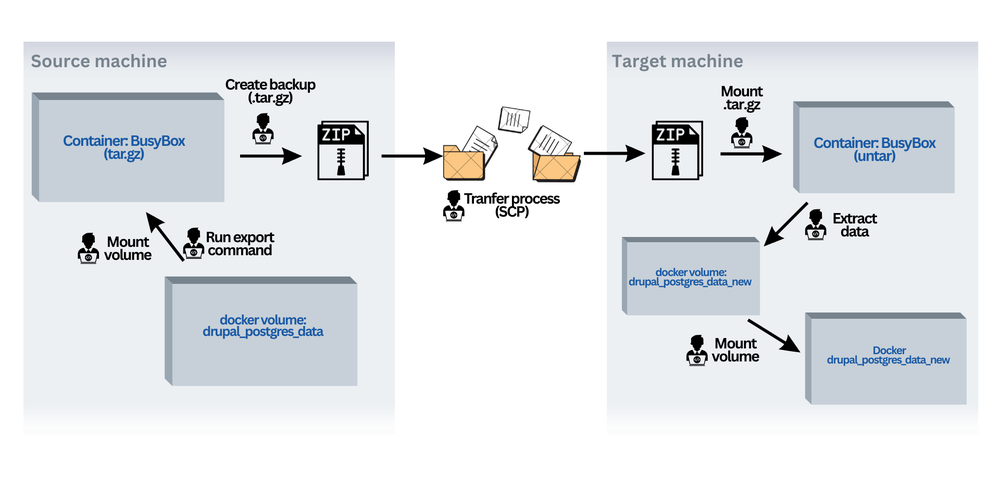Introduction
In this guide, I’ll show you how to export a Docker volume and copy it to another machine. This process involves creating a backup (tarball) of the volume, transferring it to the target machine, and extracting the content into a new volume on the target machine. We’ll use a PostgreSQL container as an example.
Step 1: Create a Container to Access the Volume
First, create a temporary container to access the volume and create a tarball containing the volume’s contents.
Run the following command in the terminal:
docker run --rm -v drupal_postgres_data:/volume -v $(pwd):/backup busybox tar czvf /backup/volume_backup.tar.gz -C /volume .
Explanation:
docker run: Runs a Docker container.--rm: Automatically removes the container after it completes its task.-v drupal_postgres_data:/volume: Mounts thedrupal_postgres_datavolume to the/volumedirectory in the container.-v $(pwd):/backup: Mounts the current directory to the/backupdirectory in the container.busybox: A lightweight Docker image with basic Linux utilities.tar czvf /backup/volume_backup.tar.gz -C /volume .: Creates a gzip-compressed tarball of the/volumedirectory.
Step 2: Copy the Tarball to the Local Filesystem
The tarball is now in your current directory. Use the scp command to copy this file to the target machine:
scp volume_backup.tar.gz user@target_machine:/path/to/destination
Explanation:
scp: Securely copies files over SSH.volume_backup.tar.gz: The tarball file to copy.user@target_machine: Username and address of the target machine./path/to/destination: Destination path on the target machine.
Step 3: Transfer the Tarball to the Target Machine
Ensure you have access rights and that the destination directory exists on the target machine.
Step 4: Extract the Tarball on the Target Machine
On the target machine, create a new Docker volume and extract the tarball into it.
1. Create a new Docker volume:
docker volume create drupal_postgres_data_new
2. Run a container to extract the tarball into the new volume:
docker run --rm -v drupal_postgres_data_new:/volume -v /path/to/destination:/backup busybox tar xzvf /backup/volume_backup.tar.gz -C /volume
Explanation:
docker run: Runs a Docker container.--rm: Automatically removes the container after it completes its task.-v drupal_postgres_data_new:/volume: Mounts thedrupal_postgres_data_newvolume to the/volumedirectory in the container.-v /path/to/destination:/backup: Mounts the directory with the tarball to the/backupdirectory in the container.busybox: The Docker image used.tar xzvf /backup/volume_backup.tar.gz -C /volume: Extracts the tarball into thedrupal_postgres_data_newvolume.
Step 5: Use the New Volume in Docker Compose on the Target Machine
Edit the docker-compose.yml file to use the new volume:
version: '3.1'
services:
db:
image: postgres:14.2-alpine
restart: always
ports:
- "5430:5432"
environment:
- POSTGRES_DB=postgres
- POSTGRES_USER=postgres
- POSTGRES_PASSWORD=postgres
volumes:
- drupal_postgres_data_new:/var/lib/postgresql/data
networks:
- drupal-nw
volumes:
drupal_postgres_data_new:
networks:
drupal-nw:
Then, restart the Docker Compose service:
docker-compose up -d
This command starts the services defined in the docker-compose.yml file.
Conclusion
By following these steps, you can successfully export a Docker volume from one machine and import it to another. This method ensures that the volume’s contents are accurately transferred and restored on the target machine.
